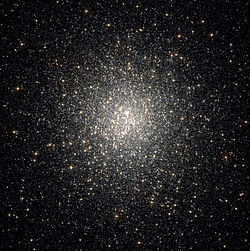Gaia Sausage
The Gaia Sausage or Gaia Enceladus is the remains of a dwarf galaxy (the Sausage Galaxy, or Gaia-Enceladus-Sausage, or Gaia-Sausage-Enceladus) that merged with the Milky Way about 8–11 billion years ago. At least eight globular clusters were added to the Milky Way along with 50 billion solar masses of stars, gas and dark matter.[1] It represents the last major merger of the Milky Way.[2][3]
Etymology
The "Gaia Sausage" is so-called because of the characteristic sausage shape of the population in a chart of velocity space, in particular a plot of radial () versus azimuthal velocity () of stars (See
The name "Enceladus" refers to the mythological giant Enceladus, who was buried under Mount Etna and caused earthquakes. Thus this former galaxy was buried in the Milky Way, and caused the puffing up of the thick disc.[2]
Components
Globular clusters
The globular clusters firmly identified as former Sausage members are Messier 2, Messier 56, Messier 75, Messier 79, NGC 1851, NGC 2298, and NGC 5286.[1]
The nature of NGC 2808

NGC 2808 is another globular-like cluster of the Sausage. It is composed of three generations of stars, all born within 200 million years of the formation of the cluster.[7]
One theory to account for three generations of stars is that NGC 2808 is the former core of the Sausage.[1] This could also account for its stellar population of over a million stars, which is unusually large for a globular cluster.
Stars
The stars from this dwarf orbit the Milky Way core with extreme eccentricities on the order of about 0.9. Their metallicity is also typically higher than other halo stars, with most having [Fe/H] > −1.7 dex, i.e., at least 2% of the solar value[4][8]
The "Gaia Sausage" reconstructed the Milky Way by puffing up the thin disk to make it a thick disk, whilst the gas it brought into the Milky Way triggered a fresh round of star formation and replenished the thin disk. The debris from the dwarf galaxy provides most of the metal-rich part of the galactic halo.[1]
See also
- Field of Streams
- Monoceros Ring
- Omega Centauri
- M32p, large galaxy merged into Andromeda Galaxy, responsible for its thick disc and most halo stars
- J1124+4535
- Kraken galaxy, another proposed large galaxy merged into Milky Way but earlier, contributed at least some of the surviving 150 globular clusters to the Milky Way.
References
Further reading
- Belokurov, V.; Erkal, D.; Evans, N.W.; Koposov, S.E.; Deason, A.J. (July 2018). "Co-formation of the disc and the stellar halo". Monthly Notices of the Royal Astronomical Society. 478 (1): 611–619. .
- Myeong, G.C.; Evans, N.W.; Belokurov, V.; Sanders, J.L.; Koposov, S.E. (April 2018). "The Milky Way halo in action space". The Astrophysical Journal Letters. 856 (2): L26. S2CID 73518200.
- Myeong, G.C.; Evans, N.W.; Belokurov, V.; Sanders, J.L.; Koposov, S.E. (April 2018). "The Shards of ω Centauri". arXiv:1804.07050 [astro-ph.GA].
- Chaplin, William J.; Serenelli, Aldo M.; Miglio, Andrea; Morel, Thierry; Mackereth, J. Ted; Vincenzo, Fiorenzo; Kjeldsen, Hans; Basu, Sarbani; Ball, Warrick H.; Stokholm, Amalie; Verma, Kuldeep (Jan 13, 2020). "Age dating of an early Milky Way merger via asteroseismology of the naked-eye star ν Indi". Nature Astronomy. 4 (4): 382–389. S2CID 210166431.
External links
- Gaia Sausage Simulation on YouTube
- Duffy, Jocelyn (4 July 2018). "The Gaia Sausage: The major collision that changed the Milky Way galaxy". Carnegie Mellon University.
- Collins, Sarah (4 July 2018). "The Gaia Sausage: The major collision that changed the Milky Way". University of Cambridge.




